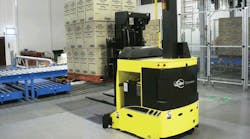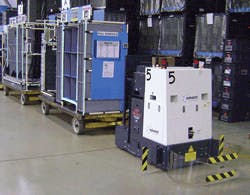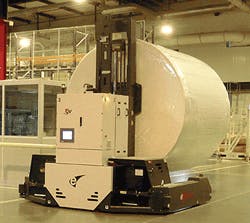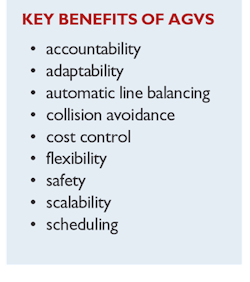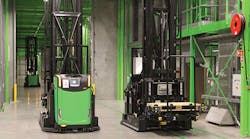In manufacturing and warehousing operations, automated guided vehicles (AGVs) are one of the most versatile solutions for in-plant transport. Automation of transportation is the key point in the production, trade and service sectors for optimizing logistics. As such, AGVs are forming the backbone for the modern material management and material handling industry.
A compact tow AGV (Savant Automation).
AGVs are driverless vehicles that are coordinated by centralized or distributed computer-based control systems and are generally used for manufacturing. They come in every feasible size and shape, varying from a small robot to huge container-handling vehicles at shipping ports. AGVs automate the handling of pallets, totes, material rolls, coils, cartons and many other types of payloads. Owing to technological advancements, industries are adopting even more aspects of automation, such as the use of AGVs for improving product quality and accuracy.
AGVs are un-manned, mobile and electric powered (battery-operated), and are capable of handling materials equipped with optical magnetic or laser guidance systems for automated functionality.
Lead, nickel-based and lithium-ion are the most commonly used batteries for AGVs; in particular, lithium-ion batteries are gaining popularity due to their cost effectiveness, light weight, high density and the ability to operate in refrigerated environments. AGVs must be manufactured in compliance with the ANSI B56.5 standard that provides the guidelines regarding vehicle safety.
A roll handling AGV (Egemin).
In the past AGV systems relied on embedded and fixed infrastructures for navigation and were used only for established and well defined processes; this has changed in recent years as technology has advanced, and today you'll find AGVs widely used in numerous end user industries. New technologies have unrestricted the vehicles from constricted areas of operations, as they've developed into more flexible and adaptable solutions.
However, modern AGV systems represent a significant investment for a company, with costs running into the millions of dollars depending on the application. These vehicles do offer dynamic design solutions that can replace conventional conveyor systems and their high associated costs. With the rapid developments in hardware and software technologies in recent years, AGVs have become more user-friendly with their graphical user interfaces. Most developments have been focused on software, safety systems and battery technology. Faster and reliable connectivity networks, such as Wi-Fi, have enabled improvements in the intelligence of management systems that are continuously guiding and controlling the AGVs.
Every AGV system must be integrated with a facility's infrastructure and the systems within the desired area of operation. Thus, routing is one of the most important factors for operating the AGVs.
This system is used for selecting the vehicle positioned with the optimum path and the destination is given by the network controller and an on-board controller navigates the vehicle. Frequency-select and path-switch are the two most commonly used methods for AGVs routing.
The ABCs of AGVs
AGVs are classified into various types, such as unit load carrying, forked, mandrel, unit load deck, load towing (tugger, tow train), and others. Unit load carrying AGVs use various deck-top mechanisms that can be used to carry and transfer a unit load. Typically, the load is carried on the top of the vehicle through a customized deck mechanism. Decks are used as load carrying devices as well as the mechanism for conveyance of the load during the transfer to the pickup and deposit stand. An advantage of a unit load AGV is its ability to carry multiple unit loads, thus increasing the throughput and efficiency of the system and reducing the number of vehicles required for the system.
Forked AGVs have standard forklift masts, and are able to interface with conventional storage rack systems. The functionality of a mandrel AGV is similar to the forked vehicles and it has standard lift mechanisms.
A vision-guided tow tractor (Raymond Corp./Seegrid).
The tugger or tow train AGV has a similar design to the standard tow tractors. The interface between the load and the AGV is made through a coupling device. These have the advantages of being able to tow a long train of carts, thus decreasing the number of vehicles needed to meet the system's throughput requirements.
AGVs are normally used for applications wherein long-distance horizontal transport of materials is required from multiple destinations, and when the tasks are very repetitive and dangerous. AGVs are typically used for raw material delivery, and for automated work-in-progress movements between manufacturing and finished goods transport in support of manufacturing production lines. Material handling systems using AGVs are commonly used in facilities such as manufacturing plants, warehouses, distribution centers and terminals. AGVs are also used in various areas for supporting processing and handling throughout a facility, such as assembling, kitting, transportation, staging, warehousing, order picking, just-in-time delivery and load transferring.
For laser triangulation, laser beams are used to scan a wall-mounted bar code reflector. In the inertial navigation system the guide path is programmed on a microprocessor which is fixed on the AGV, and a sonar system is incorporated for finding obstacles. Optical systems use photosensors to track colorless florescent particles painted on the floor. For infrared navigation systems, infrared transmitters are used to detect the position of the vehicle, and reflectors are affixed on top of the vehicle to reflect the light. Wire-guided systems incorporate an energized wire along the guide path and the antenna of the AGV follows the rooted wire.
Kiranmayi Parimi is a research analyst associate with IndustryARC, a consulting and industry analysis firm.
